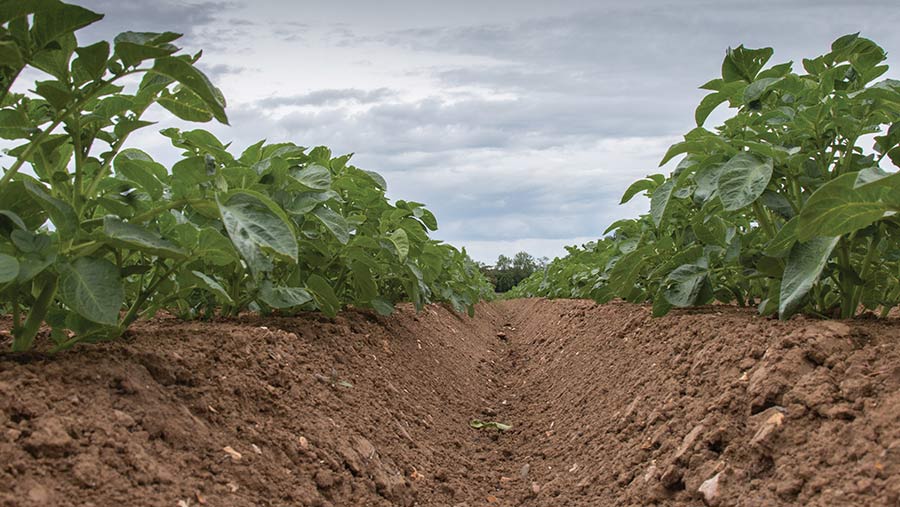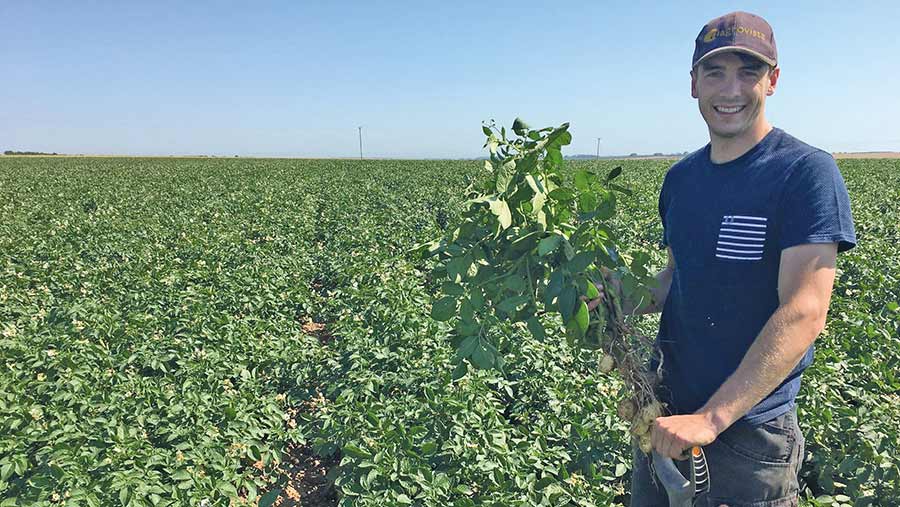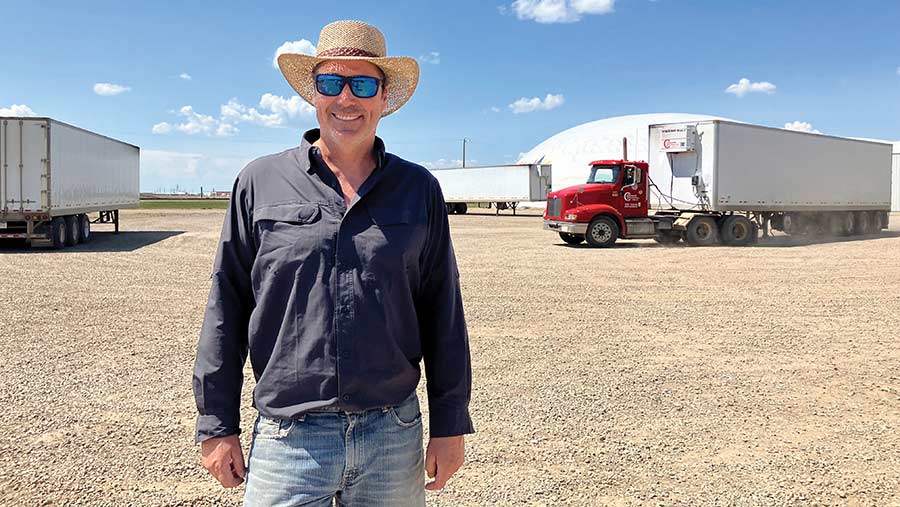Can maincrop potatoes be grown in a regenerative system?
 © Tim Scrivener
© Tim Scrivener North Yorkshire potato farmer James Pick is on a mission to future-proof production of one of the nation’s favourite carbohydrates – the potato – and believes regenerative farming practices hold the key to this.
“Increasing numbers of arable farmers are seeing the benefits of regenerative principles and improving soil health,” says James.
“But as growers become more conscious of this, potatoes are often the first crop dropped from the rotation.”
See also: Cultivation and drilling methods to rescue waterlogged soils
Together with rising input costs, poor returns, plateauing yields and extreme weather hampering the sector, potato grower numbers are dwindling and the total UK potato area is down nearly 30% since 2017.
Since returning to the family farm near Filey seven years ago, James has worked to secure a future for the farm’s 160ha potato enterprise destined for the McCain processing sector.
His Nuffield Farming Scholarship aimed to address these challenges and identify whether maincrop potatoes could be grown in a regenerative system using principles such as minimal soil disturbance and cover cropping.
As part of his study, James visited farms across Canada, the United States, Australia, New Zealand, Belgium and France, where he discovered that growing potatoes did not have to be the adversary of farmers looking after their soil.

James Pick © James Pick
James summarises three action points for UK growers to help build potato crop resilience, reduce artificial inputs and maintain yields:
- Utilise cover cropping in conjunction with a wide rotation
- Break the cycle of over-cultivation and minimise soil disturbance, moving no more than the top 25cm of soil
- Focus on improving soil biology by maintaining living roots, integrating livestock and applying manure and compost
1. Utilise cover cropping
James’ first recommendation for potato growers is to use cover crops in conjunction with a wide rotation.
“I’ve seen the positive effect a wide rotation can have on both pest and disease pressure but also on soil structure across many different farms in many different countries,” he says.
Simple actions such as establishing a cover crop in place of fallow can leave the soil covered and act as a natural “plant armour” to protect it.
Cover crops can also reduce heavy cultivation needs prior to potato establishment, as they improve soil structure. They are also a great way to increase soil organic matter, root exudates and nutrient cycling.
“One of the greatest challenges maincrop potato growers face is soil erosion, and by maintaining living roots in the ground, plants are actively pumping carbon into the soil,” he says.
“This helps aggregate soil structure and prevents erosion in extreme rain or wind.”
Example: Harold Perry, Alberta, Canada

Harold Perry © MAG/Emma Gillbard
When visiting Canadian potato grower Harold Perry, James noted the beneficial impact a wide rotation, with both cash and cover crops, had on soils.
Harold grows cereals, seed canola, legumes, cover crops and potatoes on his farm in central Alberta, with as many as 16 species in his cover crops.
“Having a diverse portfolio of cash and cover crops means a build-up of pest and disease is less likely, as well as offering multiple benefits such as feeding soil biology,” James says.
Harold carefully selects cover species that do not hamper potato production.
He avoids using species such as phacelia, instead choosing linseed, buckwheat, sunflowers, oil radish and mustard to build organic matter, cycle nutrients, add diversity and reduce disease pressure.
Not only can cover crops build soil health, they also act as bio-fumigants, reducing nematode populations.
“Whilst bio-fumigation is detrimental to soil biology, the potential reduction in nematicide requirements can pave the way for further soil health improvements,” says James.
2. Minimise soil disturbance
His next recommendation is to minimise soil disturbance and move no more than the top 25cm of soil when establishing potato crops, while creating larger soil aggregates that allow soils to breathe.
“Potato seed-beds have been overcultivated for decades, which has led to compaction and loss of organic matter and ultimately plateauing yields,” he says.
“By moving too much soil, we are not only hampering soil structure but hampering yield and leaving soils exposed to soil erosion.”
James advises growers to move to direct planting where applicable, particularly for farms with low stone contents, in order to cut establishment costs.
For non-potato crops in a rotation, he recommends moving as little soil as possible but ideally establishing crops with no-till, if soils allow, as this will provide a chance for soil structure and soil biology to recover from the effects of potato cultivation.
“I’ve seen on many farms across the globe that if we break the cycle of over-cultivation, our soils can improve and can substantially reduce establishment costs for farmers.
“Less soil movement can, therefore, reduce erosion and potentially increase yields.”
Example: Terry Buckley, South Australia
South Australian potato farmer Terry Buckley, of Buckley Farms in Mount Gambier, grows potatoes in a six-year rotation, with a five-year multispecies ley in between potato crops.
Terry puts the improvement of his light sandy soils down to moving soil less, with just seven passes of the tractor from desiccating grass to planting potatoes and returning to grass.
The first pass is glyphosate, with two cultivation passes followed by planting and harvesting.
Two post-harvest cultivation passes follow, ahead of planting the multi-species ley.
“Terry only cultivates his soils twice before potatoes to ensure overall aggregate size is larger – this means his soils don’t cap with rainfall or irrigation allowing air into the ridge,” explains James.
If no air can get into the ridge, his soil biology will not be able to breathe or reproduce, and Terry puts his ability to reduce fertiliser and pesticide use down to his thriving soil biology and balanced soils.
In contrast, conventional UK potato systems typically undergo six passes solely for establishment – ploughing, cultivating, bed-forming, bed-tilling, de-stoning and planting – with tilling and cultivating sometimes done more than once.
3. Focus on soil biology
James says: “Thriving soil biology is the perfect example of a farm putting regenerative principles into practice.
“Soils begin to function better, and can rebound from the major disturbance events of establishment and harvest of potato crops.
“Healthy soil biology has the ability to help fight off disease, while resulting plants become unappealing to pests.”
Integrating livestock, cover crops and organic amendments such as manure and compost can enhance soil health by giving soil biology the ingredients it needs to thrive.
He advises: “Get hooves into arable fields or incorporate cash or cover crop residues into our soils. Applying compost or manures is hugely beneficial.
“This will not only return nutrients into our soils but provide a food source for soil biology.”
Example: Ben Taylor-Davis, Herefordshire
After years of hard work focusing on improving soil biology, Herefordshire potato farmer Ben Taylor-Davis successfully grows potatoes without pesticides.
Ben puts the achievement down to the ability of his healthy soil and plants to resist pest and disease attack.
Ben introduced no-till to his farm after completing a 2016 Nuffield Farming Scholarship. He integrates livestock into arable fields and creates compost from cattle manure.
James says: “Compost is a great source of stable nutrients and organic matter, which is needed in soils for multiple reasons, including water holding capacity and feeding soil biology.”

